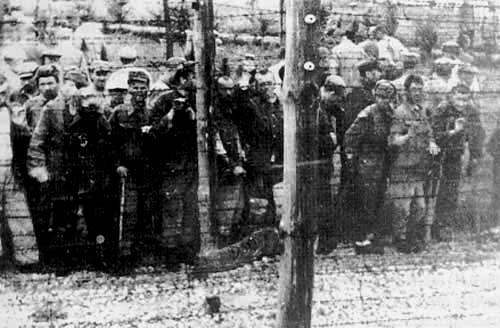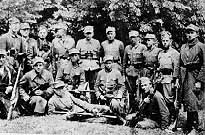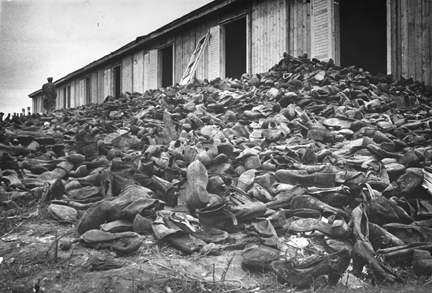The Liberation of Majdanek The Majdanek extermination camp in Lublin was liberated by Soviet troops on July 23, 1944; it was the first of many Nazi concentration camps to be liberated by the Allies. Shortly after Majdanek was liberated, a documentary film was made by the Russians. This movie was shown at the Majdanek Memorial Site in the Visitor's Center when I visited in October 1998. There are scenes in the movie which show some of the 1,500 surviving prisoners, mostly men who are not cheering the liberators, as shown in the photograph above. Although the survivors do not look emaciated, most of the men shown in the movie were on crutches or had missing feet and were walking on stumps. The movie had no explanation for this strange circumstance, but I later learned from the Museum guidebook that in early 1943, there was a hospital set up in Field II at Majdanek for wounded Russian soldiers who had been POWs, but had defected after their capture and were then wounded in fighting on the side of the Nazis against Communism. In anticipation of the arrival of Soviet troops, the Nazis had evacuated 15,000 prisoners in March and April 1944, transporting them westward by train to Auschwitz, Gross-Rosen, Ravensbrück, Natzweiler, Mauthausen, Lodz or Plaszow. The last 1,000 prisoners were marched off on foot only the day before the liberation. The Russian defectors were left behind because they were not able to join the death march out of the camp. The Russian soldiers who had defected were taken to camps in the Soviet Union after their liberation, and one can imagine their fate. Other Russian defectors who had joined the German army were taken prisoner by the Allies during the war and sent to POW camps in America. World War II was more of an ideological war between the Communists and the Fascists than a war between nations, which accounts for large numbers of Russian soldiers who switched sides and fought on the side of the Nazis. Besides these invalid soldiers, the only other survivors left behind at Majdanek were Polish peasants from the immediate area. According to a Museum booklet, a large percentage of the inmates at Majdanek were "rural people" or "peasants." Some of these Polish civilians had been imprisoned as resistance fighters after they had been ejected from their homes as part of the German plan to colonize Poland, which the Nazis referred to as "the German east." Others were from Byelorussia, a province of the Soviet Union known to Americans as White Russia, where women and children were taken prisoner in reprisal for heavy partisan fighting in that area. The Polish peasants were not shown among the survivors in the movie because they had taken the opportunity to escape while the Germans and the Russians were fighting a last-ditch battle for the city of Lublin, which lasted for two days. The Polish Home Army, a partisan group, joined the Russian soldiers in the battle to free Lublin from Nazi occupation. The photo below shows some of the Polish Home Army soldiers, including three who had escaped from Majdanek after they had been imprisoned for fighting as partisans.  When Majdanek was liberated, it was also the first time that anyone from the Allied countries had actually seen a gas chamber, although there had been plenty of news in the world-wide media about their existence, since as far back as June 1942 when the BBC first broadcast the news over the radio. It was not that the Russians unexpectedly stumbled across the gas chambers and made the shocking discovery of the Nazi killing machine; it was more like the Russians arrived at the camp and said, "Take us to the gas chambers."  The documentary film made by the Russians shows the 800,000 pairs of shoes which were found in the camp when it was liberated, but the narrator did not point out that Majdanek was a center for processing clothing taken from the Jews who were sent to the three Operation Reinhard camps at Treblinka, Belzec, and Sobibor. There was also a shoe repair shop at Majdanek where the prisoners worked on the boots of the German soldiers as well as the shoes taken from the Jews. When the camp was liberated these shoes were awaiting shipment by train to Germany where they were to be distributed to civilians in the German cities that had been bombed by the Allies. Some of the shoes from Majdanek are currently on display at the United States Holocaust Museum. The remainder are displayed at Majdanek in three warehouse buildings.  Films taken by the American Army Signal Corps at the liberation of the Nazi camps were shown in newsreels all over the world. In the photo above, the theater marquee says that a film has been held over: the Maidanek Nazi Death Factory "See SS guards executed." Maidanek was the German name for Majdanek. Death StatisticsHistoryTourGas ChamberCrematoriumBack to Majdanek indexHome |